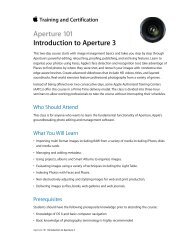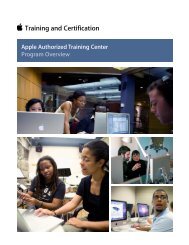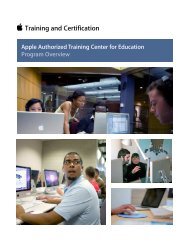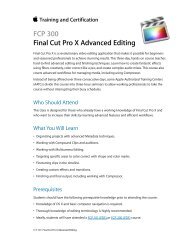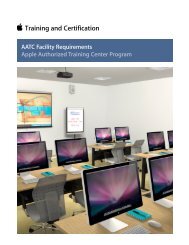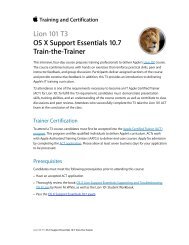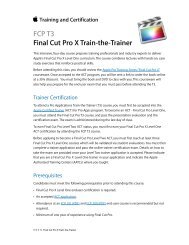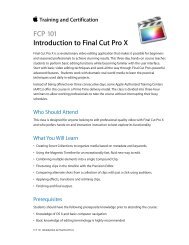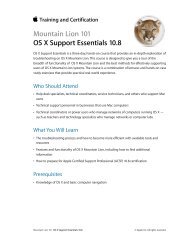OS X Support Essentials 10.8 - Training - Apple
OS X Support Essentials 10.8 - Training - Apple
OS X Support Essentials 10.8 - Training - Apple
You also want an ePaper? Increase the reach of your titles
YUMPU automatically turns print PDFs into web optimized ePapers that Google loves.
<strong>OS</strong> X <strong>Support</strong> <strong>Essentials</strong> <strong>10.8</strong> Exam Preparation Guide<br />
• File Transfer Protocol (FTP) network file services<br />
5. The Finder populates the Network folder using information<br />
provided by the dynamic network services discovery<br />
protocols. Computers providing services appear as resources<br />
inside the Network folder, while service discovery zones or<br />
workgroups appear as folders. Any currently connected<br />
servers also appear in the Network folder.<br />
6. To automatically connect a network file share when the user<br />
logs in to the system, drag the share from the Finder to the<br />
user’s login items in the Users & Groups preference in System<br />
Preferences. Alternatively, you can drag the share to the right<br />
side of the user’s Dock, and it will automatically connect<br />
when the user clicks the share’s icon in the Dock.<br />
7. The three common troubleshooting techniques for issues<br />
involving failure to connect to network services are:<br />
• Review the Network preference<br />
• Review the Network Utility statistics<br />
• Attempt to connect to different network services<br />
8. To verify a specific service is available from a service provider,<br />
first use the Network Utility Ping pane to verify basic<br />
connectivity. Then use the Network Utility Port Scan pane to<br />
verify the specific service ports are open. You should always<br />
limit the port scan to the specific ports required for the<br />
network service you’re testing.<br />
9. Files with metadata may cause problems for NFS or WebDAV<br />
network file systems. Also, avoid AFP 2 services provided by<br />
Windows file servers.<br />
Lesson Twenty-six review questions<br />
After completing Lesson Twenty-six, you should be able to answer the<br />
following questions.<br />
1. How does <strong>OS</strong> X use dynamic network service discovery<br />
protocols to access network services?<br />
2. Which two dynamic network service discovery protocols are<br />
supported by <strong>OS</strong> X?<br />
3. Which sharing services can <strong>OS</strong> X provide?<br />
4. What is the security risk of enabling client sharing services?<br />
5. Which application can provide on-demand screen sharing<br />
even when the Screen Sharing service isn’t enabled?<br />
6. What is AirDrop? How do you know if a specific Mac supports<br />
it?<br />
7. How does the <strong>OS</strong> X built-in firewall work?<br />
8. Which optional firewall settings are available?<br />
42



